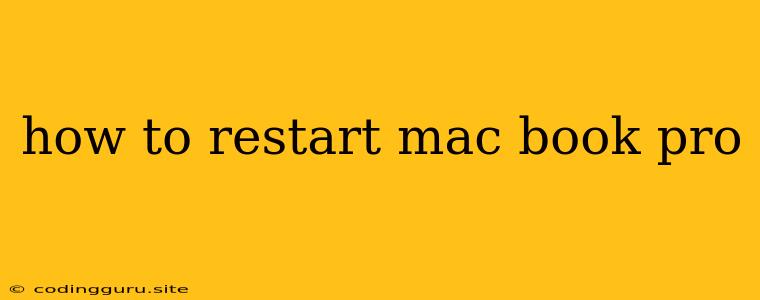How to Restart Your MacBook Pro: A Simple Guide
A MacBook Pro is a powerful machine, but even the most robust computer can benefit from a good restart. Whether you're experiencing slow performance, a frozen screen, or just need to clear your system's memory, restarting your MacBook Pro can be the solution. This guide will walk you through the simple process of restarting your MacBook Pro and address some common questions.
The Basic Restart
The most straightforward way to restart your MacBook Pro is by using the menu bar:
- Click the Apple icon in the top-left corner of your screen.
- Select "Restart" from the menu that appears.
- Confirm your choice by clicking "Restart."
Your MacBook Pro will begin the restart process, shutting down and powering back up.
Force Restarting Your MacBook Pro
If your MacBook Pro has become unresponsive and you can't use the menu bar, you can force a restart:
- Press and hold the power button located on the top right side of your MacBook Pro.
- Continue holding the power button until your MacBook Pro completely shuts down.
- Release the power button and then press it again to turn your MacBook Pro back on.
Other Restart Options
For specific situations, there are additional ways to restart your MacBook Pro:
- Restarting from the login screen: If you're at the login screen, you can click the "Restart" button in the bottom-right corner.
- Restarting from the startup manager: Hold down the Option (⌥) key while powering on your MacBook Pro to access the startup manager. From there, you can select the startup disk and click "Restart."
- Restarting with keyboard shortcuts: You can also use keyboard shortcuts to restart your MacBook Pro. Press Command (⌘) + Option (⌥) + Escape to open the Force Quit Applications window. From here, you can select "Restart."
When to Restart Your MacBook Pro
While a restart can often fix minor issues, it's not always necessary. Consider restarting your MacBook Pro in these cases:
- Slow performance: If your MacBook Pro is running slowly, a restart can help free up system resources.
- Frozen screen: If your screen has frozen and you can't use the mouse or keyboard, a restart can often resolve the issue.
- Unexpected crashes: If your MacBook Pro unexpectedly crashes or freezes, a restart can help prevent further problems.
- After installing software: It's a good idea to restart your MacBook Pro after installing new software to ensure it's functioning properly.
Conclusion
Restarting your MacBook Pro is a simple but effective way to address many common computer issues. It's a quick fix that can often resolve slow performance, frozen screens, and unexpected crashes. Remember to use the appropriate method for your specific situation, whether it's a basic restart, a force restart, or other restart options. By following these steps, you can ensure your MacBook Pro continues to run smoothly.
